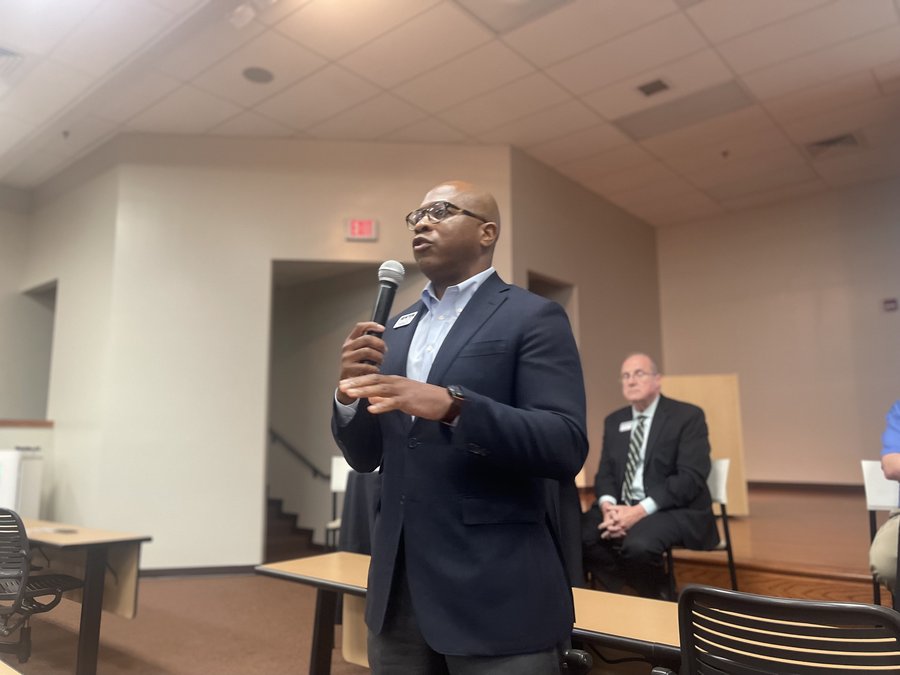NEWTON COUNTY – When it came to discussions of school safety, it was standing room only at the Safe Schools Forum held at the Newton College and Career Academy.
The forum held on Sept. 18, led to tensions rising at times. Discussions centered around how Newton County Schools (NCS) is focusing on safety throughout the district. The impetus of the forum relates to recent threats stemming from the Apalachee High School shooting on Sept. 4, which killed two students and two teachers just 40 miles away.
So far at least six NCS students have been arrested as of press time for threats related to students, teachers and/or staff.
Superintendent Dr. Duke Bradley III, along with a school safety panel were present to outline the four main pillars in how the system is addressing is focusing on safety.
The first pillar Bradley discussed was people, plans and procedures. The strategy of “See something, say something.” is the No. 1 strategy in mitigating any type of threats, according to Bradley.
Bradley also discussed the procedures in which information is being communicated to the public, citing that the school system is intent on maintaining transparent communication.
When looking at pillar No. 2, safety infrastructure was outlined as another component the system is prioritizing.
According to a powerpoint presentation from NCS, the district has invested $24 million over the last three fiscal years to enhance safety. This includes the addition to school resource officers (SRO) and the implementation of the EPIC system.
Pillar No. 3 elaborated on the code of conduct for the school system. This code of conduct is reportedly updated each year with feedback from regulatory changes, behavioral trends and feedback from stakeholders.
But when discussing how those who may be threatening the safety of school campuses may be punished, Director of student services Dr. Ashante Everett said there is no one cut and dried way on how the system disciplines these students, stating it’s all on a case-by-case basis.
“I would love to say that every student who we hear about who had a weapon, you’re never going to see them again [in NCS],” Everett said. “Unfortunately, everything we hear is not the case. Our students have to be given due process. They have to be given a quick and fair investigation.”
Discipline processes outlined for students who may threaten the safety of schools were not outlined during the presentation.
Everett also presented data from over the last year in regards to safety concerns. According to the presentation, threats to schools were down 18 percent from Aug. 2023 to Aug. 2024. Likewise, weapons on campus decreased by 25 percent and arrests on campus decreased by 55 percent in that time period. However, since the Apalachee High School shooting there has been an increase in threats to schools by 120 percent.
The last pillar outlined was mental health support. Chief strategy and support services officer Dr. Shelia Thomas said that mental health support is available for all students at all times throughout the year.

While the presentation identified the school’s strategy for tackling future incidents, several in the crowd were not pleased.
One woman said that metal detectors should be added to all schools. In response to the woman’s statement, Bradley said that it could be a possibility, citing the recent approval of a weapons detection system at Sharp Stadium.
“Our Board of Education just approved the purchase of a weapons detection system specific to Sharp Stadium, and have recently directed me to explore the prospects of what it would take to implement weapons detection systems at our schools, ” Bradley said.
The superintendent also noted that this is something worth weighing and that it should not be a “knee-jerk reaction.”
The panel was also asked how weapons are being prevented from being brought onto school buses. Chief operations officer Dr. Michael Barr said that currently the system is continuing the “See something. Say something.” method and cites that it is the top method in how weapons are detected.
When asked about SRO’s, Barr said that the system is one SRO away from the staff becoming full and complete, meaning there will be one SRO at each school.Another parent also highlighted the many actions that the school is planning on taking in the future, but she wanted to know what the school system was doing today. Barr continued to highlight the investments made in school safety to date and said that the system will continue to do so as time goes on.

To conclude, Bradley highlighted a memo from state superintendent Richard Woods, addressing the need to increase funding in safety for schools to allow crisis alert systems and SRO’s for each school across the state.
“You know what school system made sure those funds were available? Newton County Schools thanks to leadership of our Board of Education,” Bradley said.
Bradley ended on providing a declaration on how to end the epidemic of school threats.
“Our safety protocols are strong. They are resilient. They are nimble. They are intended to respond to every emergency incident,” Bradley said. “We are prepared. We are ready. Your kids are safe when they come to school.”
“There’s nothing that we can do that is full proof. Because, I also want to tell you, we need parental support.”









